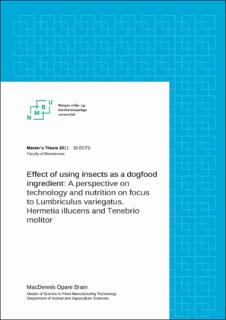| dc.contributor.advisor | Ahlstrøm, Øystein | |
| dc.contributor.advisor | Miladinovic, Dejan Dragan | |
| dc.contributor.author | Bram, MacDennis Opare | |
| dc.date.accessioned | 2021-11-15T14:24:42Z | |
| dc.date.available | 2021-11-15T14:24:42Z | |
| dc.date.issued | 2021 | |
| dc.identifier.uri | https://hdl.handle.net/11250/2829649 | |
| dc.description.abstract | The use of insect as food and feed has been in existence for a very long time as it was used as an alternative protein source for food and feed production. The current food crises has caused researchers to find ways of maximizing the production of insect to supplement some of the non conventional protein source. Insect also have high feed conversion ratio and requires less technology to produce. The blackworm (Lumbriculus variegatus) is considered a good protein source for nutrient trial application as it possesses a good nutritional profile. On the average, the black worm contains about 47.8-68% protein and 7-25% lipids which is considered good for the production of dog food. the black worm also possesses other nutrients which is beneficial for growth and development of the dogs. Also, the black soldier fly has been one of the most used insect for feed trials as well as used as food by humans. It contains about 40.1-63% protein, and 12.8-49% lipids as well as other nutrials which helps improve the wellbeing of animals. On the other hand, the mealworm (Tenebrio molitor) possesses averagely 47-55.30% protein and 22.97-37.70% lipids as well as other nutritional components useful for dog growth and deelopment. Before insect is ready to be used as feed, they need to undergo processing in other to make it easier to produce the entire dog diet and this is due to its high fat content. The insect meal goes through rheological changes during production of the dog diets and processing parameters needed to be adjusted continuously to improve quality of the extruded diets. Using insect meal as a feed ingredient also has its challenges such as consumer acceptance, price, environmental conditions, safety and allergens. | en_US |
| dc.language.iso | eng | en_US |
| dc.publisher | Norwegian University of Life Sciences, Ås | en_US |
| dc.rights | Attribution-NonCommercial-NoDerivatives 4.0 Internasjonal | * |
| dc.rights.uri | http://creativecommons.org/licenses/by-nc-nd/4.0/deed.no | * |
| dc.title | Effect of using insects as a dogfood ingredient: A perspective on technology and nutrition on focus to Lumbriculus variegatus, Hermetia illucens and Tenebrio molitor- A literature review | en_US |
| dc.type | Master thesis | en_US |
| dc.subject.nsi | VDP::Agriculture and fishery disciplines: 900 | en_US |
| dc.description.localcode | M-FT | en_US |

